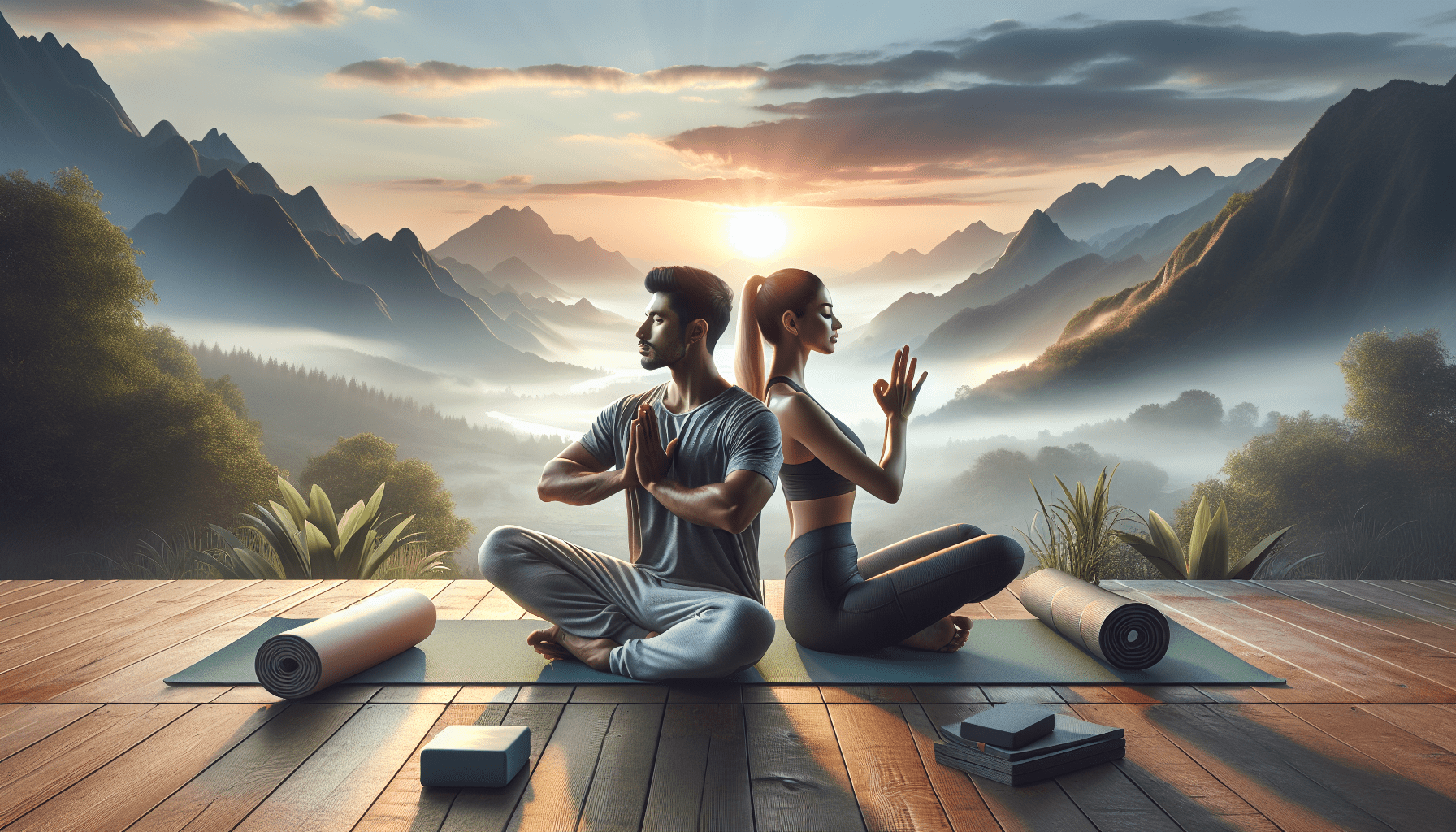Are you ready to embark on a journey of self-discovery and inner peace? As a yoga instructor specializing in working with beginners, I understand the importance of properly preparing your mind and body for a yoga session. In this article, we will explore the essential steps to ensure a fulfilling and transformative experience on the mat. Whether you are new to yoga or seeking to deepen your practice, join me as we uncover the secrets to a harmonious union of mind and body in the realm of yoga.
Choosing the Right Time and Place
Finding the perfect time and place for your yoga practice can make all the difference in creating a calm and peaceful environment. By choosing a time when you are least likely to be interrupted and a place that promotes relaxation, you can fully immerse yourself in the practice and reap its benefits.
Creating a Calm and Peaceful Environment
To create a calm and peaceful environment, start by decluttering the space where you will be practicing. Remove any distractions or unnecessary objects that may disrupt your focus. Consider playing soft music or adding calming scents to enhance the atmosphere. Creating a clean, organized, and visually pleasing environment will help to cultivate a sense of tranquility during your yoga practice.
Finding a Quiet and Comfortable Space
When choosing a space for your practice, prioritize finding a quiet and comfortable area where you can move freely without any restrictions. It could be a dedicated room, a corner of your living room, or even your backyard. Ensure that the space has enough natural light and ventilation to create an uplifting and energizing ambiance. Find a spot where you feel safe, comfortable, and free from external distractions.
Setting Aside Dedicated Time for Your Yoga Practice
To make the most out of your yoga practice, it is essential to set aside dedicated time for it. Treat this time as sacred and non-negotiable. By allocating a specific time slot for your practice, you create a routine that allows your mind and body to prepare and anticipate the session. Whether it’s early morning or in the evening, choose a time that works best for you and commit to it consistently.
Warming Up and Stretching
Warming up before starting your yoga practice is crucial for preparing your body and mind. It helps to increase blood circulation, loosen up muscles, and prevent injuries.
Importance of Warming Up Before Yoga
Warming up before yoga is essential as it helps to gradually increase your heart rate and body temperature. It prepares your muscles and joints for the more challenging asanas to come. Warming up also signals to your mind that it is time to transition into a focused and present state.
Dynamic Stretches to Loosen Up Muscles
Incorporating dynamic stretches into your warm-up routine is an effective way to loosen up your muscles and increase flexibility. These involve moving your joints in various directions, focusing on fluid movements rather than static holds. Dynamic stretches are especially beneficial in preparing your body for the dynamic movements of yoga asanas.
Specific Stretches for Different Body Parts
To ensure that all areas of your body are properly warmed up, it is important to include specific stretches for different body parts. Focus on stretching major muscle groups such as the neck, shoulders, spine, hips, and legs. Hold each stretch for 15 to 30 seconds, focusing on your breath and easing into each stretch without force or strain.
Breathing and Centering
One of the fundamental aspects of yoga is deep breathing. Incorporating specific breathing techniques into your practice can help calm the mind, increase focus, and prepare your body for the physical demands of the asanas.
Deep Breathing Techniques to Calm the Mind
Deep breathing is a powerful technique that helps to calm the mind and reduce stress. Begin by finding a comfortable seated position. Close your eyes and place your hands on your belly. Inhale deeply through your nose, allowing your belly to expand fully. Exhale slowly through your mouth, allowing your belly to contract. Repeat this deep breathing technique for several minutes, focusing on each breath and letting go of any tension or distractions.
Focusing on the Present Moment
As you continue your yoga practice, it is important to stay present and focused on the present moment. Allow your thoughts to pass by without judgment or attachment, bringing your attention back to your breath and the sensations in your body. By cultivating mindfulness and being fully present, you can deepen your connection to your practice and experience its transformative effects.
Centering Yourself Before the Practice
Before you begin your physical practice, take a moment to center yourself. Close your eyes, take a deep breath, and bring your awareness to your body and breath. Set an intention for your practice, whether it is to find peace, strength, or relaxation. Allow this intention to guide you throughout your yoga session, anchoring you in the present moment.
Choosing the Right Yoga Gear
Choosing the right yoga gear is essential for a comfortable and enjoyable practice. The right clothing, mat, and props can enhance your experience and support your body throughout the asanas.
Comfortable and Breathable Clothing
When practicing yoga, it is important to wear comfortable and breathable clothing that allows for a full range of motion. Opt for clothing made from moisture-wicking materials that will keep you cool and dry during your practice. Choose clothing that fits well and does not restrict your movement.
Yoga Mat and Props for Support
Investing in a high-quality yoga mat is crucial for ensuring stability and support during your practice. Look for a mat that provides good cushioning and grip, allowing you to move with ease. Additionally, consider using props such as blocks, straps, and bolsters to modify and adapt poses to your unique needs and abilities.
Choosing the Right Footwear
In most yoga practices, practicing barefoot is ideal as it allows for better connection with the ground and helps to improve balance. However, if you prefer to wear footwear, opt for lightweight and flexible shoes that provide minimal support and allow your feet to move naturally. Ensure that the shoes are non-slip to prevent any accidents or injuries.
Hydrating and Fuelling Your Body
Proper hydration and nutrition play a crucial role in supporting your body during a yoga session. By fueling your body with the right foods and staying hydrated, you can optimize your performance and enhance the benefits of your practice.
Importance of Hydration Before and After Yoga
Staying hydrated is essential before and after your yoga practice to maintain optimal performance and prevent dehydration. Drink water regularly throughout the day to ensure that your body is adequately hydrated. During your practice, listen to your body’s signals and take water breaks whenever necessary. After your practice, replenish your fluids by drinking water or hydrating beverages.
Eating Nutritious Foods for Energy
Fueling your body with nutritious foods is crucial for sustaining energy levels during your yoga practice. Prioritize consuming a balanced diet that includes whole grains, lean proteins, fruits, vegetables, and healthy fats. Avoid heavy or greasy meals before your practice, as they can make you feel sluggish and uncomfortable. Instead, opt for light snacks such as fruits, nuts, or smoothies that provide sustained energy.
Avoiding Heavy Meals Before Practice
It is important to avoid consuming heavy meals before your yoga practice, as they can cause discomfort and hinder your ability to move freely. Wait at least two to three hours after a heavy meal before practicing yoga to allow for proper digestion. If you are hungry before your practice, opt for a light snack that provides sustained energy without weighing you down.
Setting Intention for the Session
Setting an intention for your yoga session allows you to cultivate a deeper meaning and purpose in your practice. It helps to align your mind and body, guiding your focus and energy towards a specific goal.
Reflecting on Your Purpose for Practicing Yoga
Take a moment to reflect on why you practice yoga. Is it for physical fitness, mental clarity, stress relief, or spiritual growth? Understanding your purpose for practicing yoga will help you set a meaningful intention for your session. Whether you want to build strength, find inner peace, or simply enjoy the present moment, your intention will act as a guiding force throughout your practice.
Setting an Intention to Focus Your Mind
Once you have identified your purpose, set an intention that aligns with it. Choose a few words or a phrase that resonates with you and reflects the energy you wish to cultivate during your practice. Examples of intentions include “find balance,” “cultivate gratitude,” or “release tension.” Repeat your intention silently or aloud before beginning your practice, allowing it to anchor your mind and guide your movements.
Visualizing the Desired Outcome of the Session
In addition to setting an intention, visualizing the desired outcome of your yoga session can be a powerful tool to enhance your practice. Close your eyes and imagine yourself moving through the asanas with grace and ease. Visualize the energy flowing through your body and the positive impact the practice will have on your mind and spirit. By visualizing success, you create a positive mindset that can support you throughout your yoga journey.
Practicing Mindfulness and Meditation
Mindfulness and meditation are integral components of yoga that help to deepen your practice and connect with your inner self. By incorporating mindfulness techniques and guided meditation, you can enhance the mind-body connection and experience profound relaxation.
Incorporating Mindfulness Techniques in Your Practice
As you move through each asana, focus on bringing mindfulness to your movements and breath. Pay attention to the sensations in your body, the alignment of your posture, and the quality of your breath. Notice any thoughts or distractions that arise, and gently guide your attention back to the present moment. By practicing mindfulness during your yoga session, you cultivate a deeper state of awareness and presence.
Using Breath Awareness to Stay Present
The breath is a powerful tool for cultivating mindfulness and staying present during your practice. Throughout your yoga session, maintain awareness of your breath, observing its rhythm and depth. Use the breath as an anchor to bring your attention back whenever your mind wanders. By focusing on the breath, you can quiet the fluctuations of the mind and enter a state of deep relaxation and inner stillness.
Guided Meditation to Deepen Your Practice
Incorporating guided meditation into your yoga practice can deepen your connection with yourself and promote a sense of inner peace. After completing your physical asanas, find a comfortable seated or lying position. Close your eyes and let go of any tension or stress in your body. Follow a guided meditation that resonates with you, allowing the soothing words and imagery to guide you on a journey of self-exploration and relaxation.
Preparing the Body for Asanas
Before diving into the asanas, it is important to prepare your body through dynamic movements, strengthening exercises, and mobility exercises. These help to warm up your joints, improve stability, and enhance flexibility.
Dynamic Movements to Warm Up Joints
Dynamic movements help to warm up your joints and increase mobility. Incorporate gentle rotations and movements of the neck, shoulders, wrists, hips, and ankles to release tension and increase blood flow. Move slowly and mindfully, focusing on the range of motion and avoiding any pain or discomfort. Dynamic movements prepare your body for the more static asanas that follow.
Strengthening Exercises for Stability
Strengthening exercises target specific muscle groups to improve stability and support your body during the asanas. Incorporate core exercises, such as planks and boat pose, to strengthen the abdominal muscles. Include exercises for the legs, such as lunges and squats, to build stability and balance. Strengthening exercises not only enhance your physical practice but also contribute to overall body strength and resilience.
Mobility Exercises for Flexibility
Flexibility is a key component of a well-rounded yoga practice. Incorporating mobility exercises helps to improve flexibility and range of motion in your joints. Practice gentle stretches and movements that target specific areas of your body, such as forward folds, spinal twists, and leg stretches. Move mindfully and gradually, respecting the limits of your body and avoiding any pain or discomfort. Regular mobility exercises will gradually improve your overall flexibility.
Mindful Transitions Between Asanas
The transitions between asanas are as important as the poses themselves. By maintaining consciousness and practicing smooth and controlled movements, you can flow seamlessly from one pose to another, creating a harmonious and meditative practice.
Maintaining Consciousness during Asana Transitions
As you transition between asanas, remain conscious and focused on your movements. Avoid rushing or hurrying through the transitions. Instead, move mindfully and deliberately, paying attention to the alignment, breath, and sensations in your body. By maintaining consciousness during the transitions, you connect each pose with grace, creating a more seamless and unified practice.
Smooth and Controlled Movements
Smooth and controlled movements are essential in creating a flowing yoga practice. As you move from one pose to another, focus on the fluidity and grace of your movements. Avoid sudden or jerky motions that can create strain or tension in your body. Instead, move with intention and awareness, allowing the transitions to become an integral part of your practice.
Avoiding Jerky or Hasty Transitions
Jerky or hasty transitions can disrupt the flow and mindfulness of your practice. Take your time and move at a pace that feels comfortable for you. Avoid forcefully pulling or pushing your body into the next pose. Instead, allow your breath and the natural rhythm of your movement to guide you. By avoiding jerky or hasty transitions, you maintain a sense of ease and grace throughout your practice.
Cooling Down and Relaxation
After an invigorating yoga session, it is important to cool down your body and mind, allowing them to return to a state of relaxation and balance. Cooling down helps to prevent muscle soreness, enhance flexibility, and promote overall well-being.
Gentle Stretches to Cool Down the Body
Gentle stretches are an excellent way to cool down the body after an intense yoga practice. Focus on lengthening and releasing the muscles that were worked during the session. Incorporate gentle forward folds, seated twists, and hip openers to release any tension or tightness. Move slowly and honor your body’s needs, avoiding any strain or discomfort.
Savasana for Deep Relaxation
Savasana, also known as the Corpse Pose, is a powerful tool for deep relaxation and integration. Lie down on your back, feet hip-width apart, and arms relaxed by your sides. Close your eyes and allow your body to completely surrender to the ground. Release any remaining tension and focus on your breath, allowing it to guide you into a state of deep relaxation. Stay in Savasana for several minutes to fully reap its benefits.
Incorporating Yoga Nidra for Ultimate Relaxation
Yoga Nidra, also known as yogic sleep, is a guided meditation technique that promotes deep relaxation and rejuvenation. Lie down in Savasana and follow a Yoga Nidra audio or video recording. Allow the soothing voice to guide you through a state of deep relaxation, systematically releasing tension from each part of your body. Yoga Nidra not only relaxes the body but also calms the mind, leaving you feeling refreshed and rejuvenated.
In conclusion, preparing for a yoga session involves more than just rolling out your mat and starting the asanas. By carefully choosing the right time and place, warming up and stretching, focusing on your breath and centering yourself, choosing the right gear, hydrating and fueling your body, setting intentions, practicing mindfulness and meditation, preparing your body for asanas, transitioning mindfully, and cooling down and relaxing, you can create a comprehensive and fulfilling yoga practice that nourishes both your mind and body. Remember to listen to your body, honor your limits, and enjoy the journey as you embark on the path of yoga. Namaste!







